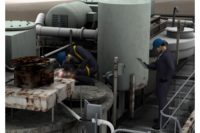A mining disaster that led to safety changes
"Mining is a hazardous profession"

Fifty-one years ago today, a massive explosion and fire killed 78 coal miners in West Virginia and led to significant changes in mining safety through the passage of the 1969 Coal Mine Safety and Health Act.
On Sunday, family members of the workers who perished in the Farmington Mine disaster and coal miners and their families gathered in Marion County for a solemn ceremony that has taken place every year for more than a half a century, at a monument engraved with the names of the victims who were trapped in the mine, unable to escape.
The early morning blast at the Consol No. 9 coal mine was so strong it was felt nearly a dozen miles away. A Nov. 21 article from the Times-West Virginian gives a vivid account of the incident: “Rolling smoke, lightened by flames that last night shot 150 feet into the air, poured from the Llewellyn Run and Mod's Run portals of the ill-fated mine, while noxious gases filled the workings and threatened to add to the four explosions which rocked the mine starting at 5:25 a.m. and continued until 10 p.m.”
Twenty-one miners of the 99 in the mine at the time were able to make it to the surface.
The fires that followed the explosion burned for more than a week, stymying rescue efforts and forcing officials to seal the mine with concrete on November 30 in order to extinguish the fires. Recovery efforts – hampered by cave-ins - continued for ten years. The bodies of 19 miners were never recovered.
West Virgnia’s governor, Hulett C. Smith, said at the time that he had "confidence that the mining industry is seeing the most improved safety measures are being taken. We have experienced tragedy here many times before. Mining is a hazardous profession.”
The 1969 Coal Mine Safety and Health Act was the most comprehensive and stringent federal legislation governing the mining industry to date. It increased the number of inspection of coal mines, gave miners the right to request a federal inspection, called for mandatory fines for violations and provided benefits to miners disabled by black lung disease.
Although the specific cause of the blast and fire were not confirmed, inadequate ventilation was cited by the Mine Safety and Health Administration in a 1990 investigation as a factor. Inadequate control of explosive methane gas and coal dust and inadequate testing for methane may have also played a part.
Looking for a reprint of this article?
From high-res PDFs to custom plaques, order your copy today!






.jpg?t=1721257160)
